- A group of thirty three yatris went for the Kailash Mansarovar Yatra. Read about their experiences.
The Kailash Mansarovar Yatra is an experience of a life-time. It is said that one can go only when there is a Bulava or Calling! Our group was thus
named Kailash Calling. If one does not listen to the calling and gives Shivji
excuses, I am busy at work, he might create a situation where you break attachments
and visit his abode.
The attitude one goes with
determines the experience. Those who go with humility and love for Bholenath,
invariably return spiritually enriched.
In
2018, a group of us completed our yatra with the ISHA Foundation. We enjoyed
ourselves but this yatra takes you up to the north-facing Kailash at Dirapuk
and does not include the full Parikrama. Not doing the Parikrama left a void within
some of us and a deep yearning to do it. As one of us is 69 years of age and the age
limit is 70 we decided to go for the yatra in 2019 itself.
So
we quickly formed a group around a core of 9 who in turn put together a group of 33 members by including friends and family. This article consist of numerous personal experienes, some of which are part of the article while others are shown at end as experience of individual yatris.
Having formed the group it seemed like I was set to go.
There was a mystic drama that played
out before we boarded our flight. On August 7 we were told we may not get Visa since
China was upset because the Government of India had scrapped Article 370 in Jammu
and Kashmir. Nothing new. A friend who went in 1998 had to face similar drama
because India had exploded a nuclear bomb that year.
The next day we were told that the yatra may get delayed and that we had to prepone our trip by three days as the Tibet border would close to Indians by September 10. Flights had to be rescheduled but at least we were going!
It is Shivji’s way of testing your resolve. Here is a story. In 2012, one of my friends went to Mahavatar Babaji Cave in Dunagiri Kumaon. It is about a one hour trek from the road high up in the mountains. Enroute he met a couple who said they were returning because could not find the way. My friend smiled, he too got lost but his driver companion said it was Babaji’s way of testing his devotees. If you lost your way and got disheartened Babaji’s cave was not for you. The Holy Gita teaches us the importance of perseverance.
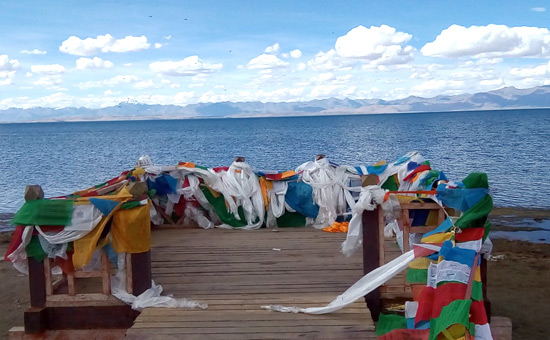 Magical Mansarovar with Kailash.
Magical Mansarovar with Kailash.
Kailash Mansarovar requires inner
transformation before we start the yatra
The journey to Kailash is a personal journey for your “Self”. It is one way of connecting the ATMA with the higher energies of Kailash. Mount Kailash is where the complete knowledge of the universe is stored in a holy mountain.
The word Atma connect has a bigger meaning that the journey itself. Atma Connection
happens when we go there as a pilgrim and not as a Trekker. A pilgrimage means the person transforms himself from the journey. It means he rises up as a “Soul ”.
The transformation happens when the person contemplates on any areas of his journey. It could start from a basic question “Why am I making this journey to Kailash”. Is it because my friends are going? If the answer is yes then what is my inner yearning.
During this contemplation, you can come up with thoughts of what is needed for you to work upon for e.g. have I improved as a human being or become more loving or caring or both. This contemplation is happening in the deep of your core than just the mental body. The answers come from within. “When you get the answers and you start to work on it, your life gets transformed gradually.”
Therefore,
a Kailash Yatra is meant to connect with the higher energies and become
blissful. Whether or not you do the Parikrama is meaningless if you do not
connect with the energies of Kailash. If a person who connects even from
Mansarovar but does not do the Parikrama will be joyful from the journey.
There
are people who have visited Kailash many times. It carries no meaning if there
is no deeper connect. Even after so many journeys, if you still have jealousy,
anger, lust, desire, envy, competitiveness, fear then they were trekkers and
nothing more.
This journey is for your “self”. If you spoke with your family daily or were busy sharing pictures over Whats App it means that the Atma connect with Kailash is weak or missing. A deeper connect would mean you have felt the completeness for which you don’t need anybody else. A friend who went years told me that whilst going to Kailash he spoke the most for five days, on return he was silent.
Building your stamina
before departure
My
health was certainly better than last year since I had started a few kriya
practices that helped me cope with the altitude reasonably well. I highly
recommend Sukh Kriya for all those
who wish to undertake this yatra. This is like Anulom Vilom but to be done very
gently so that even a hair on a feather placed under the nostril does not
flutter.
One needs to build stamina and improve breathing. Important to reduce body weight if required, walk, climb stairs, do Yog Asanas and Pranayam. Also during the yatra keep the mind uncluttered, chant Om Namah Shivay, pray for Shivji’s kripa and keep fingers in Pran Mudra to enhance Prana or life energy.
At that altitude oxygen is less, it
could start raining or and get very cold. Pray to Shivji continuously and
remain unflustered with the obstacles that might come your way.
Back to the Yatra
Unlike Isha which takes you to Kathmandu and Lhasa by air this yatra takes a different route. We flew into Lucknow. From there took a bus to Nepalgunj, next a 20 seater aircraft to Simikot (2910 metres), by helicopter to Hilsa (3635 metres), by bus to Taklakot in Tibet (4755 metres) and lastly by bus to Mansarovar (4590 metres) and Darchen i.e. the base for Kailash Parikrama. We used a Delhi based travel company ‘Kailash Journeys’. As we had booked a year in advance we got a discounted price of Rs 1.65 lakhs per head payable in instalments. Cost is Lucknow to
Lucknow and includes transport, guide, food etc.
We were fortunate to have four
doctors in our group, so a thorough medical check-up was mandatory. In a
lighter vein two essentials for the Kailash Yatra. Your group must have doctors
and Gujaratis, the latter because they get lovely snacks and in large
quantities.
Facilities varied from place to
place. At Nepalgunj, we had the equivalent of a three star accommodation which
was comfortable. Two shared a room which had attached toilets. At Nepalgunj we waited
an extra day as flights were delayed due to bad weather. We had our passports
stamped here. Everyone felt disappointed yet faith kept their enthusiasm high.
 Aircraft that took us to Simikot.
Aircraft that took us to Simikot.
A short flight took us to Simikot.
The planes are 20 seaters and named Tara or Sita. Since we decided that ours
was a Sitara group, some flew by Sita and others by Tara!
In Simikot which is a very small
town, the Potala Palace Lodge was very basic. 4-5 persons shared a room which
had a toilet attached. But you needed to step out to a neighbouring plot for a
hot shower. Hilsa had very limited lodging boarding facilities. We were forced
to move to a newly built lodge which had cleaner rooms and an attached toilet -
again 3-4 sharing a room. We spent one night at Hilsa too.
We crossed a river walking on a swinging bridge to buses that ferried us to Taklakot in Tibet, after an exhaustive physical search of each of our duffle bags knapsacks and more important each of our mobiles to check if any had the picture of the Dalai Lama on it! Finally, passports stamped, fingers printed and iris scanned we arrived at the hotel in Taklakot.
Detailed information about the
boarding and lodging facilities is for those to whom this matters and for women
where it is important.
Reach Manasrovar (4500
M)
We left Talakot for Mansarovar on
the auspicious day of Ganesh Chaturthi and went to the bewitching Rakshashtal
first. It is so calm, so blue, and so clear that one cannot attribute anything
sinister to it and all we saw is divinity everywhere. One is not allowed to
touch the water just in case we are harmed in any way. We were told all the punya you may get by reaching Mansarovar may be neutralised by touching water of Rakshashtal yet one almost found it irresistible.
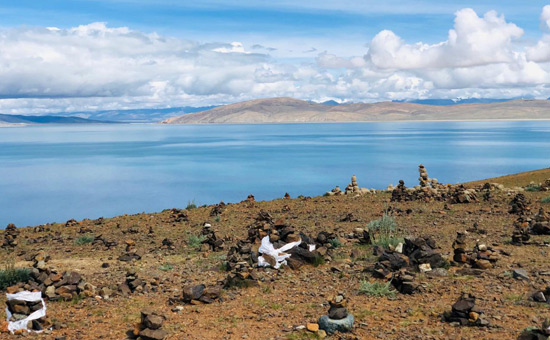 Rakshashtal
Rakshashtal
We reached Mansarovar around noon.
The scene was spectacular. After lunch we left for a Parikrama of the lake, a
good 90 kms drive around the lake spread over three hours. We stopped at a
point where we were allowed to collect water and enter the lake. Cold yet warm,
so exquisite was the experience. The sun was shining brightly. Some of the
members developed a headache - one vomited. The doctors got worried since we
had yatris with high blood pressure, diarrhoea and headache. Doctors did
medical checks and distributed medicines.
I
call it Magical Mansarovar as it never fails to amaze me with its brilliance whether at daybreak or during the setting rays of the sun- it holds you spellbound. Watching the star filled sky or lying on your back on the banks of the lake, cannot be described in words. And whenever it was time to leave I would be in tears.
Next day we trekked to the Chiu Monastery. Chiu (Sparrow) Monastery enjoys a fabulous location atop a craggy hill overlooking Mansarovar. The monastery's name comes from the story that Guru Rinpoche was guided here by a sparrow before staying for seven days. As it was a clear day Mt Kailash loomed dramatically to the north.
Later in the evening we had a
meeting with the doctors who had the unenviable task of telling six of us to
sign a high risk consent form for continuing the Yatra. Three were advised to
stay back. They stayed back in Darchen in a hotel that offered a view-darshan
of Kailash 24 by 7.
 Yamadwar is from where the parikrama begins.
Yamadwar is from where the parikrama begins.
Parikrama begins
The Parikrama started on September 4 from Yamadwar in Darchen.
It
is important only to mention that the actual Yamadwar is a configuration of
boulders. This was discovered on that trek 26 years ago and as no one had known
about it, a deep desire to share the discovery had got hold of me. The Way of the White Clouds by Lama Angarika
Govinda is the book where there is a reference of this configuration of
boulders which forms a tunnel through which one passes lying down and squeezes,
slithers through. The belief is that one could save a life time if one
successfully completed it.
We had a lunch pack, water bottles
and a porter who carried our essential stuff in a backpack.
From our group of 33, thirty proceeded
to Diraphuk (4890 M) eight walked whilst the rest hired ponies. The cost of a
pony and porter for four days is 4,500 yuans ie Rs 46,000/. You can hire a pony
for 800 Yuans for one day of the climb to Dolma pass which some of us did.
 On a poney.
On a poney.
It took 5-6 hours to reach Diraphuk.
All were silently chanting the name of Mahadev enroute and enjoying the beauty
of the stunning landscape with the river gurgling alongside. We proceeded at a
steady pace, not forgetting for a moment that we were in the presence of the
holiest mountain and highest energy centre of the world.
After a few hours of trekking, the
prayer flags came into view, signifying that the west face of Kailash was around
the corner. He seems so near- just a few hundred yards away- almost within
touching distance. But that was an illusion.
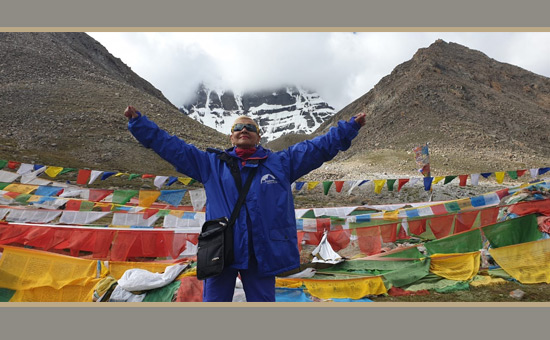 Prayer flags with Holy Kailash in the background.
Prayer flags with Holy Kailash in the background.
We bowed down, offered prayers and
were humbled seeing some Tibetans doing the Parikrama through a series of full
prostrations. It takes atleast two weeks to complete the Parikrama this way. We
finally reached Diraphuk where the north facing Kailash unfolded itself, fully
visible under the clear skies and setting sun - looking magnificent and a
welcoming sight to the weary pilgrim who is overwhelmed with tears of profound gratitude at seeing him so
clearly.
 North facing Kailash.
North facing Kailash.
At Mansarovar, two night stay in
Diraphuk and one night stay at Zuthulpuk there were no toilet or bathing
facilities. It is so cold and oxygen less that that the last thing one thinks
of is bathing. Nevertheless we had gone well stocked with wet wipes and toilet
rolls that served us well. Our four member doctor team monitored the BP, pulse
rate and oxygen retention of every member twice a day.
We halted at Derapuk for the night
as all of us wished to experience Charan Sparsh. Next morning we trekked for a
couple of hours or as much was possible. It was not an easy climb through the
rocky uneven path with the glacier waters flowing down and weaving through the
pathway.
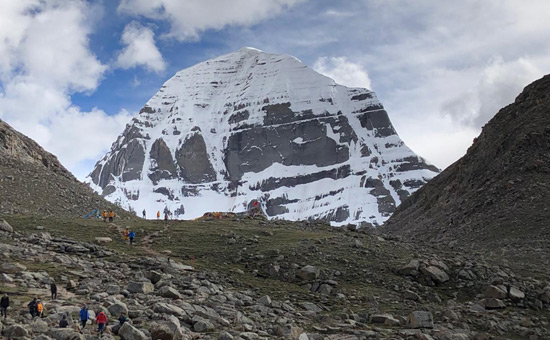 North facing Kailash at Deraphuk. Devotees walking for Charan Sparsh.
North facing Kailash at Deraphuk. Devotees walking for Charan Sparsh.
After
I reached the limit of my physical endurance to experience Charan Sparsh I stopped
and chanted Yogeshwaraya Mahadevaya a
couple of times, loudly and clearly and was in tears by the end of it. My heart
just burst with emotion for Mahadeva and hoped he would hear my silent and not
so silent prayer. It was to me the highest point of my Parikrama. A friend
climbed up and saw Om Parvat.
To hear Yogeshwaraya
Before we proceeded further fourteen members returned to Darchen as they were either not physically fit or felt they could not carry on. So sixteen were left for the final Parikrama. Four did so foot and the rest partly on pony since the pony does not take you down Dolma pass. Also the trek on the last day is so pleasant that most of us walked.
Dolma La is the Tibetan name of
Goddess Parvati, wife of Shivji residing at Mount Kailash. It is said that one
can cross only if Goddess Dolma La allows you to. Today, she was kind
enough to bestow her blessings and we crossed the pass with no hindrance at
all.
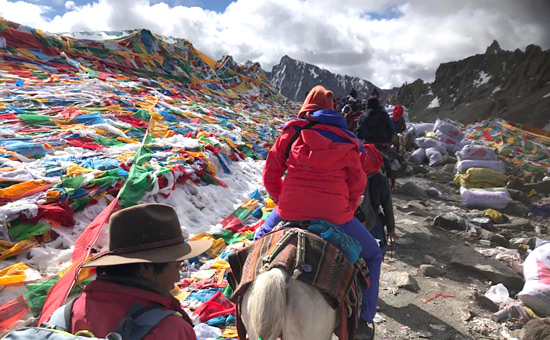 Going up Dolma Pass
Going up Dolma Pass
The next day most of us proceeded to
Dolma Pass on ponies. The weather had held out beautifully on all the days so we
did not need raingear. We briefly saw the north and east facing Kailash as we
proceeded and made it to the top on our ponies.
 North and east facing view of Kailash.
North and east facing view of Kailash.
After walking for about six kms, a sea
of Prayer flags greeted us at Dolma Pass (19500 feet) the highest point in the Parikrama.
Then began the slightly treacherous trek downwards of about 3 kms. If there is
snow on the pass make sure to put your foot on a shoe mark means someone walked
on it before so safe.
On our way down the beautiful
emerald green Gauri Kund was a sight
to behold! It looked surreal and I could almost visualise Goddess Parvati
having a dip in this beautiful Kund.
 Gauri Kund.
Gauri Kund.
The remaining trek was fairly smooth
and easy! Suddenly the entire landscape changed and became green as far as the
eye could see!
Now some personal experiences.
Yatri 1
26
years ago my husband and I had done the Parikrama on foot, just the two of us!
Living in tents under starry skies almost getting blown off! But that is
another story. My second trip was with Isha Foundation and this my final and
third pilgrimage.
It
is important only to mention that the actual Yamadwar is a configuration of
boulders. This was discovered on that trek 26 years ago and as no one had known
about it, a deep desire to share the discovery had got hold of me.
Even
though I was desperate to show it to the team, I knew that if I have to ride
the horse, I would not be able to reach Yama Dwar. Sonam, my ponyman was
determined to just reach me up to the pass without mishap and he simply just
did that. My heart was heavy although I had surrendered to Kailashnath and
asked, He take my ego away.
Imagine my delight when, as I descended the steep path on foot the team members caught up with me and exclaimed they had found, filmed and traversed it. My joy knew no bounds. Although I did not see it again in which He showed me that my ‘I’ was taken away the team members did in which He revealed His compassion.
 On way down from Dolma Pass are Yatris 1 and 2.
On way down from Dolma Pass are Yatris 1 and 2.
Yatri 2
We were very lucky to get a clear darshan of the south facing Kailash which I missed during last year’s yatra.
To me, the Mansarovar experience was as significant as Kailash. It had lingered with me throughout last year. This year we planned a 90 kms drive around the Mansarovar. It is the highest fresh water lake in the world and one can spend hours along the banks watching the changing colours of the waters and the ducks and gulls swimming peacefully in small groups.
Yatri 3
My Kailash yatra from the mundane to the sublime, the journey within.
My second trip to Kailash. I was thrilled that Shivji invited me to his abode again. When I first went in 2010 was discovering myself and in 2019 I knew myself better or so is what I thought. There were many lessons I had to learn, the biggest one being how miniscule I am really am as in the EGO! The problems arise when we disconnect from the divine under the false pretence that we alone are controlling our lives. The Unknown was doing I do not know what, but it worked out perfectly when I let go of my ineffectual attempts to control and just allowed the unknown to flow freely!Things changed when I surrendered
to Bholenath. Payments, travel dates, flight bookings, helicopter rides,
hotels, passports, and visa nothing went as per ‘plan’ and yet It all went as
per plan just not my plan!
I express gratitude to those fellow yatris, who calmed me down from ‘Rakshas Taal’
all agitated and angry to ‘Manasarovar’ calm, in the flow, peaceful!
What I was ‘shown’ I was physically
capable of walking all the way, no pain, no cramps no soreness no
breathlessness, no accelerated heart rate. I was truly blessed to be in such
good physical shape.
In retrospect my journey within was remarkable and the lessons I learnt are intrinsic to my inner being. The majestic Kailash humbled me and has transformed me into a mellower version of myself!!
Let us spread love, respect, harmony, and positivity for ourselves and others everywhere.
Shirin and Sandi have contributed to this article. Pictures are by fellow yatris.
Dhanyavad, Aabhar, Nandri Shivji for making this yatra happen. Pranams.
Om Namah Shivay
 You see us with folded hands after completing the Parikrama.
You see us with folded hands after completing the Parikrama.